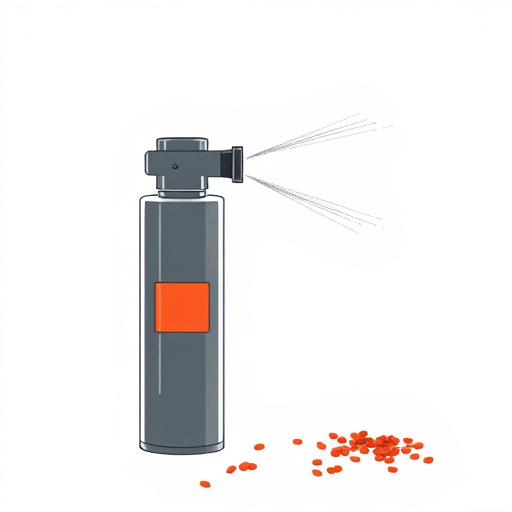Capsicum, an active ingredient in pepper spray, causes sensory disruption upon exposure. The Pepper Spray Eye Washing Procedure, involving 15+ minutes of water rinsing, dilutes and flushes capsaicin to reduce eye discomfort. Immediate action is crucial to mitigate symptoms and prevent long-term effects. Global regulations govern pepper spray's sale, possession, and use, emphasizing training, licensing, distribution guidelines, and clear product instructions for safe and effective personal protection.
“Discover the power of a capsicum-based personal protection spray—a revolutionary non-lethal self-defense tool. This article delves into the science behind this potent defense mechanism, exploring how capsaicin, the active ingredient, disrupts assailants’ senses and provides crucial time for escape. We’ll guide you through the effective pepper spray eye washing procedure, ensuring safety and proper response to exposure. Additionally, we’ll navigate legal implications and safety regulations surrounding these self-defense devices, empowering individuals with knowledge.”
- Capsicum: The Active Ingredient Explained
- How Pepper Spray Works Against Threatens
- Eye Washing Procedure: Steps and Precautions
- Legal Implications and Safety Regulations
Capsicum: The Active Ingredient Explained
Capsicum, often referred to as chili pepper or capsaicin, is the active ingredient in personal protection sprays, commonly known as pepper spray. This natural compound is derived from various species of Capsicum plants and is responsible for the spicy sensation felt when consuming chili peppers. However, its application extends far beyond culinary delight, especially in self-defense mechanisms.
When used in eye washing procedures after exposure to pepper spray, capsicum plays a crucial role. The irritant nature of capsaicin triggers a rapid response from the body’s nervous system, causing eyes to water and tear up as a defense mechanism. This natural reflex helps to flush out and dilute the effects of the pepper spray, providing temporary relief and allowing for better visibility. Understanding this active ingredient is essential in comprehending the effectiveness of pepper spray and its corresponding eye washing procedures for personal safety.
How Pepper Spray Works Against Threatens
Pepper spray, a powerful personal protection tool, works by targeting the senses and temporarily disabling an attacker. When deployed, it releases a fine mist containing capsaicin, the active ingredient found in chili peppers. This substance irritates the eyes, nose, and respiratory system of the target, causing them to become tearful, coughing, and having difficulty breathing. The effect is immediate, providing users with crucial time to escape or de-escalate the situation.
The eye washing procedure is a critical component of pepper spray safety. If exposure occurs, it’s essential to rinse eyes thoroughly with water for at least 15 minutes. This action helps dilute and flush out the capsaicin, alleviating discomfort and preventing further irritation. Proper eye washing after using pepper spray can significantly reduce recovery time and ensure users maintain clear vision as soon as possible.
Eye Washing Procedure: Steps and Precautions
In case of exposure to pepper spray, immediate action is crucial to mitigate its effects, especially on sensitive areas like the eyes. The pepper spray eye washing procedure involves several steps that can significantly reduce discomfort and potential damage. Start by removing any contact lenses if present, as they may trap the spray. Then, gently rinse your eyes with clean, warm water for at least 15 minutes, ensuring thorough flushing of the irritants.
During the eye washing process, avoid rubbing your eyes, as it can spread the pepper spray particles further. Use gentle, slow movements to pour the water over your closed eyelids. Seek immediate medical attention if irritation persists or if you experience any vision changes. Remember that proper eye washing can greatly alleviate symptoms and protect your eyes from potential long-term effects of pepper spray exposure.
Legal Implications and Safety Regulations
The legal implications surrounding capsicum-based personal protection sprays, commonly known as pepper spray, vary across jurisdictions. In many countries, these self-defence devices are regulated under specific legislation targeting their sale, possession, and use. The focus is often on ensuring public safety and preventing misuse. For instance, some regions mandate that pepper spray users undergo training or possess a licence to carry such items.
Safety regulations also play a pivotal role in managing the distribution and application of pepper spray. Proper eye washing procedures, for one, are crucial following exposure to the irritant. Users must be instructed on the correct techniques to minimize damage from accidental spraying. Moreover, manufacturers are responsible for providing clear instructions and warnings, ensuring consumers understand the product’s capabilities, limitations, and potential side effects. Adhering to these guidelines is essential not only for legal compliance but also for effective personal protection.
A capsicum-based personal protection spray, also known as pepper spray, is a powerful tool for self-defence. Understanding how it works, its active ingredient (capsicum), and the eye washing procedure after use is crucial. Always follow safety regulations and be aware of legal implications to ensure responsible usage. Remember, proper knowledge and preparation can make all the difference in potentially dangerous situations.
